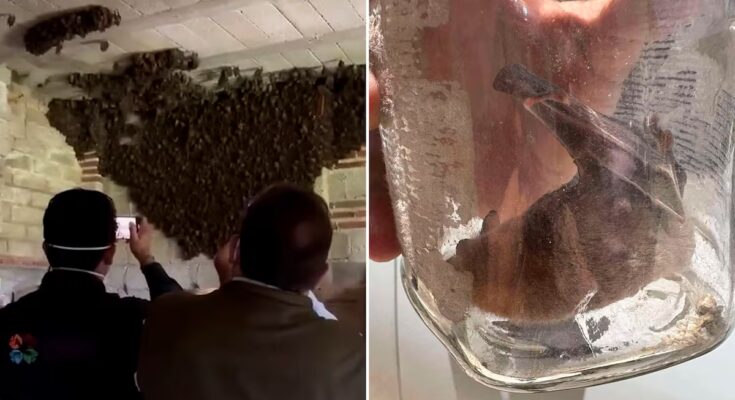When Mr. Jorge Nocelo went down to the basement of his house in Natívitas, Tlaxcala (Central Mexico) looking for a lid, he did not expect to find tenants in his property. Between dolls, strollers and other gadgets, that open space above a ravine where his family stored everything they no longer used regularly had become the new home of hundreds of bats. Although he didn’t recognize them at first, he only needed to shine a little light to distinguish the small bats famous for hanging upside down.
Enriqueta Nocelo, their 19-year-old daughter, says they weren’t scared when they saw them, but they were alarmed by the quantity. “It was the worry of what are we going to do, are they fed up, and saying that these little animals have rabies, that they attack and that they can be contagious,” he explains. Faced with this scenario, the family asked the Civil Protection for help to “make them escape”, but only after carrying out a visit to the house did the authorities glimpse the extent of the situation. According to Queta, as he prefers to be called, at that time there were around 1,000, but at one point they reached 2,000.
After a few calls, help arrived from the La Malinche Scientific Station, located on the slopes of the inactive volcano of the same name and which belongs to the Tlaxcala Behavioral Biology Center of the Autonomous University of Tlaxcala. Doctor of Biological Sciences from the Autonomous University of Mexico (UNAM) Jorge Ayala, who has dedicated more than 30 years to the study of these animals, went with his team to the home of the Nocelo family to verify that it was the species leptonycteris yerbabuenaealso known as the lesser long-tailed bat.
The researcher explains that this type of bats are migratory and feed mainly on nectar. Furthermore, he highlights their unique role as pollinators: “The agave tequila exists only thanks to this species, it is the only one that pollinates the blue agave. This makes it a species, let’s say, economically important because, thanks to it, we have tequila.” Although the Nocelo family had asked for help to remove the bats from their property, the scientist made them a counter-proposal. “The other option I gave them was to leave them,” he says, adding that, due to their numbers, it would be very difficult to catch them all and it was possible that many of them would die in that attempt. “The idea was to cover the entrances to the place where they were staying and have them go elsewhere, but that meant the bats would look for another house nearby that would host them and it was like a never-ending story,” he says.
Dr. Ayala made it clear to the family that since this species is migratory, they would not stay there forever and that, after a few weeks, they would leave. He also gave them a workshop where he addressed the importance of these animals to the ecosystem and debunked some of the myths that exist around them. “Bats, rather than being enemies of humans, are just the opposite, because they provide us with what we call environmental services,” he says, explaining that these bats function as pest control and help in the germination of many seeds. As for the belief that they suck blood, it is clear: “In the world we have about 1,500 species of bats in total, and of these there are only three that feed on blood, that is, less than 1%.”
In the end the family accepted the researcher’s proposal. In this regard, Queta shares: “We prefer to leave them in their space like this, without disturbing them, and until they want to leave.” But when the news reached the neighbors’ ears, alarm bells began ringing through misinformation. “They got scared. They started saying that we already had rabies, that we were infected with some disease, that these bats can attack people and so on, many things,” Queta says. Because of the commotion, the scientist and his team organized a seminar with the municipality of Natívitas, attended by at least 100 people, to dispel the myths that were circulating in the community.
As for coexistence with the bats, the young woman explains that her family avoided visiting the cellar, which is located next to her house, during the magueyeros’ stay. “These little animals get really angry when they see people. They don’t attack, but they get nervous, they start flapping their wings a lot and move from side to side,” he says. The researcher emphasizes that bats, like any other animal, attack only to protect themselves: “Even pets, if they are not yours, do this. If you want to grab them, they will defend themselves because they don’t know you and they don’t know that you won’t hurt them.” Furthermore, it ruled out that they posed a danger of contracting rabies due to the low incidence. “A bat can bite you and that doesn’t guarantee you’ll get rabies,” he adds.
A problem that arose during the animals’ stay in the Nocelo family’s home was the bad smell. Queta assures that “it was strong”, but that “it did not reach the neighbors”. To resolve this issue, the La Malinche Station team undertook to clean the place to reduce the stench that existed. According to Ayala this was due to the animals’ excrement since the males of that species have a spot on their back with a particular smell to attract females. Thanks to coordination with other authorities and institutions, such as the Tlaxcala Altiplano Zoo, the Ministry of the Environment and Natural Resources (SEMARNAT) and the National Commission of Protected Natural Areas (CONANP), two cleanings were carried out in the warehouse where the bats were housed with the participation of approximately 12 people.
Although the first cleaning was carried out at night, taking advantage of the fact that in that period the number of bats was low because they went out to eat, for the second cleaning, at the beginning of September, the tenants of the Nocelo family were no longer in that space. Queta says that they realized that the animals were leaving because one night they noticed a lot of commotion. “We heard a lot of banging, they were quite nervous. (There was) a lot of noise and movement,” he describes. And so, after just over two months, the thousands of bats that arrived at the Nocelo family’s home in July had already left what was their temporary home.
A few days ago the Federal Attorney General for Environmental Protection (PROFEPA) awarded the Nocelo family an award “for the responsible and ethical management of a bat colony”. Queta says that she and her family feel “grateful and happy to have supported them” and assures: “It is very pleasant to be able to help our ecosystem a little and learn from a species that many believe to be insignificant.” Dr. Ayala told EL PAÍS that the American organization Bat Conservation International will also recognize the family’s work with an award, but did not provide further details.
The extraordinary story of the Nocelo family could have a second part next year. According to the researcher from the Behavioral Biology Center of Tlaxcala who assisted the family, it is likely that the magueyeros will return in 2026. “For some reason they liked it there. The most likely thing is that they will return to that house,” he says. While Queta says his family hasn’t yet decided whether to receive them again, he doesn’t rule it out either: “We’re thinking about whether to leave it like this so they can come back or close it and have them look around for something.” For Ayala, whatever the family decides, the outcome is already positive. “They are the heroes because they allowed the bats to stay there,” he concludes.



